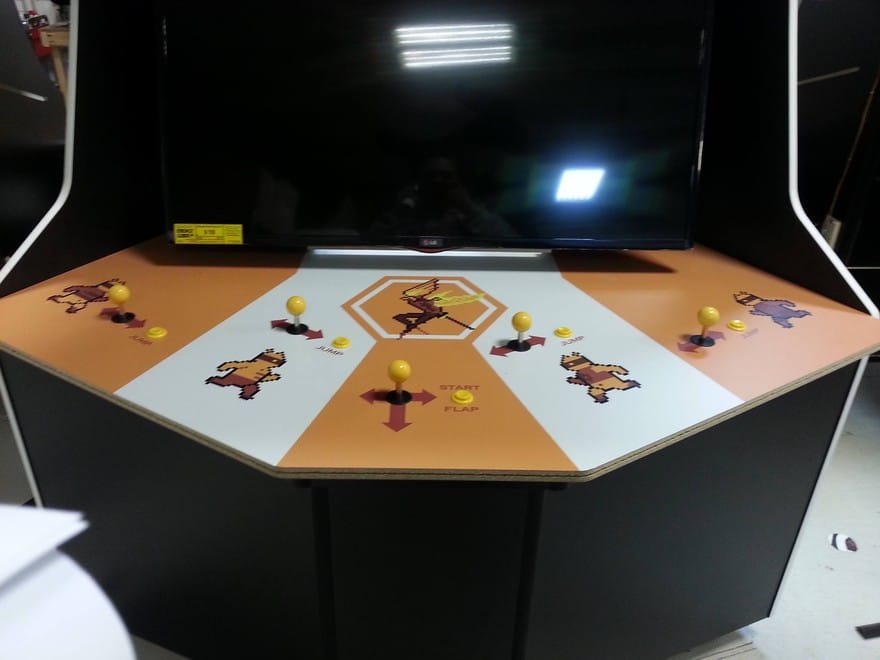Babycastles and the hunt for new arcade spaces

After playing Turnover (“a four player multigravity steal-the-ball-n-run frenzy”) for the first time at IndieCade East’s Show & Tell session this past weekend, I had to ask the obvious questions to the developer: “Is this due for a home release?”
This was obvious due to the orientation of the screen: flat on its back. Living in an NYC apartment, my tiny space’s contents are akin to Jenga, and doing something as bold as repositioning the TV might topple all of the adjacent IKEA furniture and ruin all of my high fantasy books. Though an absolute blast to play, setting up Turnover seems like a big ask; normally the only thing that merits special space arrangements for is the potential-gropefest of a game of Twister. He was nevertheless optimistic that players would make accommodations, and maybe he’s right.
But what about some of the other unusual games you see coming out of the indie scene? How do home gamers accommodate, say, 3D Pac-Man, the lofty variant that’s projected onto 4 surfaces in an empty room? Where does an indie arcade cabinet for a 5v5 real time strategy game go when it’s no longer being featured in a museum show? What happens when a controller is so unique that only one copy exists, as with Sword Fight? Where do these games call home?

If Babycastles has their way, these games will find a home in a gallery in Brooklyn, NY.
The programmer collective Babycastles has curated several shows since 2010 featuring some of the more prominent names in videogames. Their stated mission is to showcase the full breadth of what gaming can offer, often blurring the lines between physical and digital gaming, always with a DIY punk aesthetic.
Since late 2013, they’ve begun fundraising efforts to open a more permanent shelter for these sorts of homeless titles and recently announced that they’re halfway to their “definitely definitely happening” gallery goal that’s set to open within a matter of months. Not just limited to spotlighting Brooklyn gaming, their two upcoming shows will focus on Islamic indies and indies from mainland China, as per the spirit of inclusivity they spoke of in their talk at IndieCade East.
With the Indie Essentials exhibit ending soon at the Museum of the Moving Image and the Deathmatch by Audio events quickly outgrowing their space on the heels of an explosive turnout, the need for a bigger, dedicated space to house these unique works is pressing. Between the popular esports highlights and special night event at IndieCade East, the hidden theme of the event seems to have been the universal quest to find and build a New Arcade.
When I attended the Babycastles talk, I’d expected to hear them outline their plans for the upcoming gallery space and maybe tease some new information. Instead, founders Syed Salahuddin and Kunal Gupta fondly recalled the history of Babycastles and highlighted some of its more memorable moments. Perhaps everyone in the audience was familiar with their mission enough that a trip down memory lane would automatically make us allies of the gallery crowdfunding plans, but I think that Syed and Kunal missed a captive opportunity to evangelize the benefits of having a permanent space.
The biggest danger presented by the talk is overlooking others with comparable goals and fracturing the New Arcade community.
They glossed over their narrative as transients, which lead to gaps in time of (seeming) inactivity. They could’ve also acknowledged the collectives who are also attempting to curate indie gaming scenes and venues in, I’d argue, very similar mission statements, whether in NYC or elsewhere (particularly in LA and especially the successfully crowdfunded LA Game Space). The biggest danger presented by the talk, and, indeed, Babycastles’ future plans, is overlooking others with comparable goals and fracturing the New Arcade community.
As classic arcades make a resurgence, there’s no room for independently published titles. Spaces like Barcade, which is full of Pac-Man and Joust machines, hold nostalgic appeal to those who have fallen out of gaming, but a new space (and a strong case) is needed for people still actively interested in the medium.
Nevertheless, the talk did serve to remind us how the organization’s quest to find a home was a quest we all shared: we’re seeking that old couch with old friends to play exciting new games with each other, to be awed by the never-before-scene potential of new releases, to feel 10 years old again. Whether it’s Dark Souls changing the rules of a genre or QWOP making us re-learn how to walk, having real-world forums to celebrate these milestones in gaming (and to house those unique games that have one controller/cabinet in existence) is the missing element of modern videogames.



